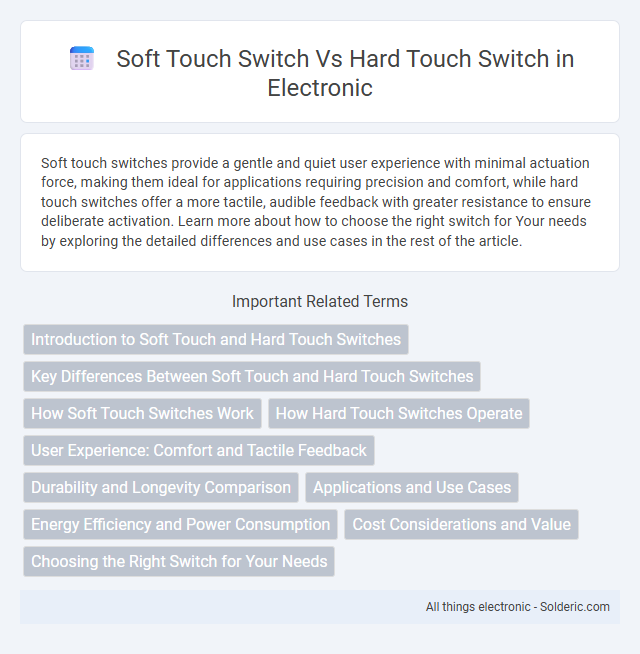Soft touch switches provide a gentle and quiet user experience with minimal actuation force, making them ideal for applications requiring precision and comfort, while hard touch switches offer a more tactile, audible feedback with greater resistance to ensure deliberate activation. Learn more about how to choose the right switch for Your needs by exploring the detailed differences and use cases in the rest of the article.
Comparison Table
| Feature | Soft Touch Switch | Hard Touch Switch |
|---|---|---|
| Actuation Force | Low force required (soft press) | High force required (firm press) |
| Tactile Feedback | Light, smooth feedback | Strong, noticeable feedback |
| Durability | Moderate lifespan | High lifespan, more durable |
| Common Applications | Mobile devices, touchscreens | Industrial controls, heavy machinery |
| Noise Level | Quiet operation | Louder click sound |
| Cost | Generally lower cost | Higher cost due to durability |
Introduction to Soft Touch and Hard Touch Switches
Soft touch switches provide a gentle, low-force activation experience, ideal for user interfaces requiring frequent or delicate inputs. Hard touch switches offer a more tactile, firm feedback with greater actuation force, suitable for applications demanding precise, durable responses. Understanding these switch types helps you select the best option for your device's usability and performance needs.
Key Differences Between Soft Touch and Hard Touch Switches
Soft touch switches require minimal pressure to activate, providing a gentle and quiet response ideal for sensitive or frequent use applications. In contrast, hard touch switches demand firmer pressure and offer more tactile feedback, making them suitable for environments where accidental activation must be avoided. Key differences include actuation force, feedback intensity, and user experience, influencing their choice based on specific operational needs.
How Soft Touch Switches Work
Soft touch switches operate by applying minimal pressure to activate an electrical circuit, relying on a membrane or tactile dome beneath the surface that collapses under light finger force. This design offers a quiet, low-resistance response ideal for sensitive devices and enhances user comfort by reducing finger fatigue. Your interaction with soft touch switches benefits from their durability and smooth feedback, making them preferred in modern electronics over hard touch switches that require more force.
How Hard Touch Switches Operate
Hard touch switches operate through a mechanical mechanism that requires a firm press to activate the electrical circuit, providing tactile feedback and a distinct clicking sensation. Their design includes a spring-loaded actuator that resets the switch after each press, ensuring precise and reliable operation. These switches are commonly used in devices requiring deliberate, deliberate inputs such as keyboards, industrial equipment, and some consumer electronics.
User Experience: Comfort and Tactile Feedback
Soft touch switches provide a gentle, responsive feel that enhances comfort by requiring minimal pressure, reducing finger fatigue during prolonged use. Hard touch switches offer more pronounced tactile feedback with a firm click or resistance, improving precision and ensuring each press is distinctly registered. Your choice depends on whether you prioritize a smooth, effortless interaction or a more deliberate, tactile confirmation.
Durability and Longevity Comparison
Soft touch switches typically offer higher durability due to their membrane or capacitive design, which reduces mechanical wear and extends lifespan up to 10 million actuations. Hard touch switches rely on physical contacts that can degrade over time, often lasting around 1 to 5 million cycles before failure. The longevity advantage of soft touch switches makes them preferable for high-frequency use in consumer electronics and industrial controls.
Applications and Use Cases
Soft touch switches are ideal for consumer electronics like smartphones, tablets, and remote controls, where gentle and responsive interaction enhances user experience. Hard touch switches are commonly used in industrial machinery, appliances, and control panels, offering durability and tactile feedback under rigorous conditions. Your choice depends on the application's requirement for sensitivity versus robustness and environmental resilience.
Energy Efficiency and Power Consumption
Soft touch switches require minimal force for activation, resulting in lower energy consumption during operation compared to hard touch switches that need greater pressure. The reduced mechanical effort in soft touch designs enhances overall energy efficiency, making them more suitable for battery-powered and low-power devices. Hard touch switches often demand more power to register a press, which can lead to increased energy usage over time.
Cost Considerations and Value
Soft touch switches generally incur higher manufacturing costs due to the use of advanced materials and technology, which can increase the initial investment for electronics manufacturers. Hard touch switches, being simpler in design and made from less expensive components, offer a cost-effective solution ideal for budget-conscious projects. Despite the higher price, soft touch switches provide enhanced durability and user experience, delivering greater long-term value in premium or frequently used applications.
Choosing the Right Switch for Your Needs
Soft touch switches provide a gentle, low-force actuation ideal for devices requiring frequent, quiet operation, such as remote controls and mobile devices. Hard touch switches offer a more tactile and audible feedback, which suits applications demanding precision and durability, including industrial equipment and mechanical keyboards. Selecting the appropriate switch depends on the user's preference for feedback intensity, durability requirements, and the device's operational context.
soft touch switch vs hard touch switch Infographic

 solderic.com
solderic.com